Citroen BERLINGO MULTISPACE RHD 2015.5 2.G Owner's Manual
Manufacturer: CITROEN, Model Year: 2015.5, Model line: BERLINGO MULTISPACE RHD, Model: Citroen BERLINGO MULTISPACE RHD 2015.5 2.GPages: 292, PDF Size: 10.74 MB
Page 121 of 292

119
Berlingo-2-VP_en_Chap05_Securite_ed02-2015
ANTI-SLIP REGULATION (ASR)
AND
DYNAMIC STABILITY
CONTROL (DSC)
These systems are linked and complement the ABS.
The
ASR
system is very useful for
maintaining
optimum drive and
avoiding losses of control of the vehicle
on
acceleration.
The
system optimises drive to prevent
the
wheels skidding, by acting on the
brakes
of the drive wheels and on the
engine.
It also allows the directional
stability
of the vehicle to be improved
on
acceleration.
Use the
d SC to hold your course
without
attempting to countersteer.
If there is a variation between the
trajectory
followed by the vehicle and
that required by the driver
, the d SC
system
automatically acts on the
engine
and the brake of one or more
wheels,
in order to put the vehicle back
on
course.
Deactivation
In certain exceptional conditions
(starting the vehicle when stuck in mud
or
snow, or on loose ground...), it could
prove useful to deactivate the a
SR and
DSC
systems to make the wheels spin
and
regain grip.
Operating fault
Good practice
The ASR/DSC systems offer increased safety
during normal driving, but
should
not incite the driver to take risks
or
to drive at high speed.
The
operation of these systems is
ensured
if the recommendations
of
the manufacturer regarding
the
wheels (tyres and rims), the
braking
components, the electronic
components
and the fitting and repair
procedures
are observed.
After
an impact, have these systems
checked
by a CITROËN dealer or a
qualified
workshop.
Operation
The warning lamp flashes when operation of the a SR or
DSC
is triggered.
They engage again:
-
automatically
above 30 mph
(50
km/h), When
a malfunction of the systems
occurs, the warning
lamp
and the LED come on,
accompanied
by an audible
signal
and a message in the
screen.
-
Press the button or turn
the dial to the
d SC o FF
position (depending on
model).
-
The
LED comes on: the
ASR
and
DSC
systems no longer come into
play
. -
manually
by pressing the
button again or by turning
the dial to this position
(depending
on model).Contact a CITR
o Ë n dealer or a
qualified
workshop to have the system
checked.
The
warning lamp may also come on if
the
tyres are under-inflated. Check the
pressure
of each tyre.
driving safely
SaFETY
5
Page 122 of 292

120
Berlingo-2-VP_en_Chap05_Securite_ed02-2015
GRIP CONTROL
Correct use
Your vehicle is designed principally to
drive
on tarmac roads but it allows you
to drive on other less passable terrain
occasionally
.
However, particularly when your
vehicle is heavily laden, it does not
permit
off-road activities such as:
-
crossing and driving on ground
which
could damage the underbody
or
tear off components (fuel pipe,
fuel
cooler, ...), particularly by
obstacles or stones,
-
driving on ground with steep
gradients and poor grip,
-
crossing
a stream.
On
snow,
mud
or
sand,
traction
control
is
obtained
by
a
compromise
between
safety
, grip, traction and appropriate
tyres.
It
adapts
to
allows
most
conditions
of
poor
grip
to
be
accommodated.
The
accelerator
pedal
must
be
pressed
enough for there to be adequate
engine
power
to
manage
the
various
parameters
in
the
best
way.
driving safely
Page 123 of 292
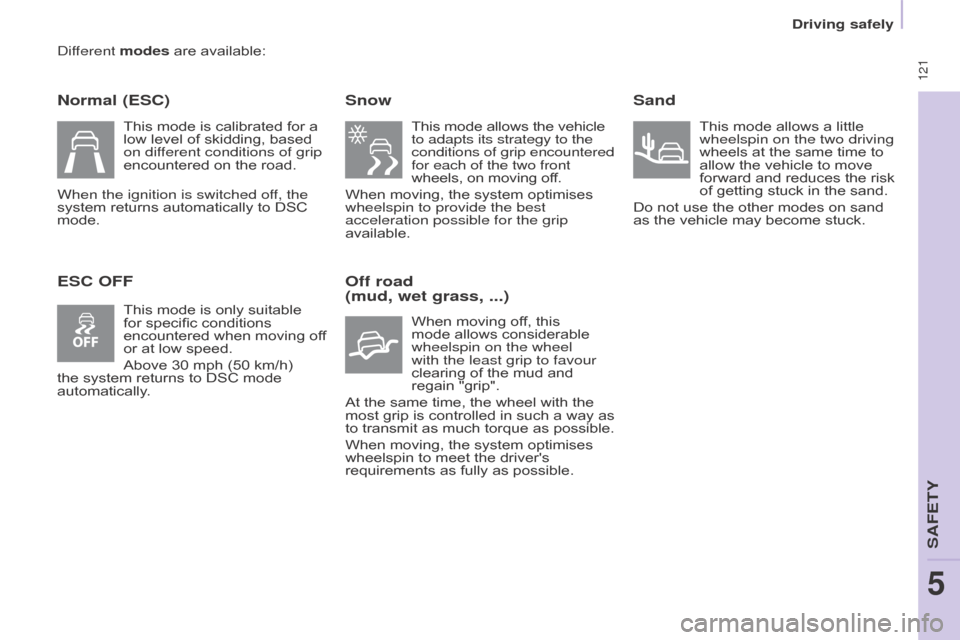
121
Berlingo-2-VP_en_Chap05_Securite_ed02-2015
different modes are available:
Normal (ESC)
ESC OFFSnow
This mode allows the vehicle to adapts its strategy to the
conditions of grip encountered
for each of the two front
wheels,
on moving off.
When
moving, the system optimises
wheelspin to provide the best
acceleration possible for the grip
available.
Off road
(mud, wet grass, ...)
When moving off, this mode allows considerable
wheelspin on the wheel
with the least grip to favour
clearing
of the mud and
regain
"grip".
At
the
same time, the wheel with the
most
grip
is controlled in such a way as
to
transmit as much torque as possible.
When
moving, the system optimises
wheelspin
to meet the driver's
requirements
as fully as possible.
Sand
This mode allows a little wheelspin on the two driving
wheels at the same time to
allow
the vehicle to move
forward
and reduces the risk
of
getting stuck in the sand.
Do
not
use the other modes on sand
as
the
vehicle may become stuck.
This
mode
is
calibrated
for
a
low
level
of
skidding,
based
on dif
ferent conditions of grip
encountered
on
the
road.
When the ignition is switched off, the
system
returns
automatically
to
DSC
mode.
This
mode
is
only
suitable
for
specific
conditions
encountered
when
moving
off
or
at
low
speed.
Above
30
mph
(50
km/h)
the
system
returns
to
DSC
mode
automatically
.
driving safely
SaFETY
5
Page 124 of 292

122
Berlingo-2-VP_en_Chap05_Securite_ed02-2015
ACTIVE CITY BRAKE
Active City Brake is a driving assistance
system that aims to avoid
a frontal collision or reduce the speed
of
an impact if the driver does not
react
sufficiently (inadequate brake
application).
This
system is designed to
improve
driving safety.
It
remains the driver's responsibility to
continuously
monitor the state of the
traffic
and to assess the distances and
relative
speeds of other vehicle.
Active
City Brake can in no
circumstances
replace the need for
vigilance
on the part of the driver. Never
look at the laser sensor
through
an optical instrument
(magnifying
glass, microscope...)
at a distance of less than
10 centimetres:
risk of eye injury.Principle
Using a laser sensor located at the top
of the windscreen, this system detects
a
vehicle running in the same direction
or
stationary ahead of your vehicle.
When
necessary, the vehicle's braking
system
is operated automatically
to avoid a collision with the vehicle
ahead.Automatic
braking occurs later
than if done by the driver
, so as
to intervene only when there is a
high
risk of collision.
Conditions for activation
Active City Brake only operates if the following conditions are met:
●
ignition
on,
●
the
vehicle is in a forward gear,
●
speed
is between about 3 and
18 mph
(5 and 30 km/h),
●
the
braking assistance systems
(ABS,
EBFD, emergency braking
assistance) are not faulty
,
●
the
trajectory control systems
(
a SR, d SC) are not deactivated or
faulty,
●
the
vehicle is not in a tight corner,
●
the
system has not been triggered
during
the previous 10 seconds.
driving safely
Page 125 of 292

123
Berlingo-2-VP_en_Chap05_Securite_ed02-2015
Operation
When your vehicle is too close to or
approaches the vehicle ahead too
quickly the system automatically
applies
the brakes to avoid a collision.
You are then alerted by the display of a
message.
The
brake lamps on your vehicle come
on
to warn other road users.
The collision can be avoided
automatically
if the difference in
speed between your vehicle and the
vehicle
ahead does not exceed 9 mph
(15 km/h).
Above
this threshold, the system will
do what is possible to avoid or reduce
the accident by lowering the speed of
impact.
The
automatic braking may bring
the
vehicle to a complete stop if the
situation
requires it.
In this case, the vehicle is held
stationary
temporarily (for about
1.5 seconds)
to allow the driver to take
back
control by pressing the brake
pedal. The
triggering of the system may cause the engine to stall, unless
the driver depresses the clutch
pedal
quickly enough during automatic
braking.
During
automatic braking, the
driver can always obtain a higher
rate of deceleration than that
controlled
by the system, by pressing
firmly
on the brake pedal.
After
an impact, the system is
automatically
put out of service: it
no
longer operates.
You
must go to a CITROËN dealer or a
qualified
workshop to have the system
made
operational again.
Operating limits
The system only detects vehicles that are stationary or moving in the same
direction
as your vehicle.
It
does not detect small vehicles
(bicycles,
motorcycles),
pedestrians
or animals, nor non-
reflective
stationary objects.
The
system is not triggered or is
interrupted
if the driver:
-
accelerates strongly
-
or turns the steering wheel
suddenly
(avoiding manoeuvre).
In
difficult weather conditions (very
heavy
rain, snow, fog, hail...),
braking
distances increase, which
can
reduce the ability of the system to
avoid
a collision.
The
driver must therefore remain
particularly
vigilant.
Never
leave accumulations of
snow
or any object projecting
above the bonnet or in front of
the
roof: this might fall into the field of
vision of the sensor and generate a
detection.
driving safely
SaFETY
5
Page 126 of 292

124
Berlingo-2-VP_en_Chap05_Securite_ed02-2015
Deactivation
The system is deactivated in the vehicle configuration menu, accessible
with
the ignition on.
Its
state is memorised when the
ignition
is switched off.
When
the system is deactivated,
a
message is displayed every
time
the ignition is switched on,
to
warn you. With the monochrome screen C
F
Press the
MENU button for access
to
the main menu.
F
Select "
Personalisation-
Configuration".
F
Select "
Define vehicle
parameters".
F
Select "
Driving assistance".
F
Select "
Automatic emergency
braking: OFF" or "Automatic
emergency braking: ON".
F
Press the "
7" or "8" button to
check
or uncheck the box and
activate
or deactivate the system
respectively
.
F
Press the "
5" or "6" button, then
the OK button to select the "OK"
box
and confirm or the Back button
to
cancel.With the touch screen tablet
F
Press the " MENU" button.
F Select the " Driving" menu.
F
In the secondary page, select
"
Vehicle settings".
F
Select "
Driving assistance" tab.
F
Check
or uncheck the "Automatic
emergency braking" box to
activate
or deactivate the system.
F
Confirm.
driving safely
Page 127 of 292
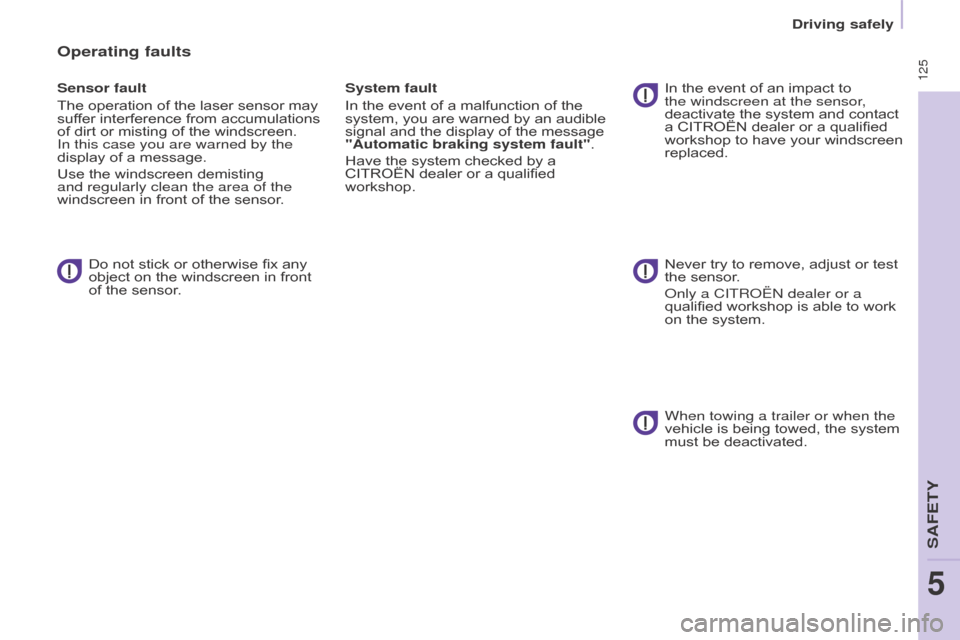
125
Berlingo-2-VP_en_Chap05_Securite_ed02-2015
Operating faults
Sensor fault
The operation of the laser sensor may
suf
fer interference from accumulations
of
dirt or misting of the windscreen.
In this case you are warned by the
display
of a message.
Use
the windscreen demisting
and regularly clean the area of the
windscreen
in front of the sensor.
Do
not stick or otherwise fix any
object
on the windscreen in front
of
the sensor. System fault
In
the event of a malfunction of the
system,
you are warned by an audible
signal
and the display of the message
"Automatic braking system fault"
.
Have
the system checked by a
CITROËN
dealer or a qualified
workshop.In
the event of an impact to the windscreen at the sensor
,
deactivate
the system and contact
a
CITROËN dealer or a qualified
workshop
to
have
your
windscreen
replaced.
Never
try to remove, adjust or test
the
sensor.
o
nly a CITR o Ë n dealer or a
qualified
workshop is able to work
on
the system.
When towing a trailer or when the
vehicle
is being towed, the system
must
be deactivated.
driving safely
SaFETY
5
Page 128 of 292
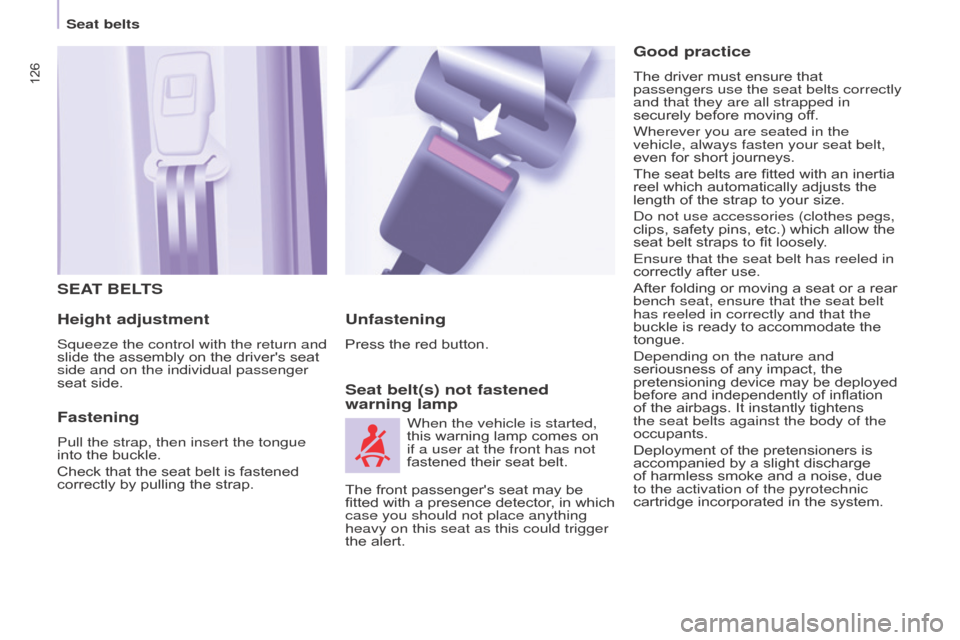
126
Berlingo-2-VP_en_Chap05_Securite_ed02-2015Berlingo-2-VP_en_Chap05_Securite_ed02-2015
SEAT BELTS
Height adjustment
Squeeze the control with the return and
slide the assembly on the driver's seat
side and on the individual passenger
seat
side.
Fastening
Pull the strap, then insert the tongue
into the buckle.
Check
that the seat belt is fastened
correctly
by pulling the strap.
Seat belt(s) not fastened
warning lamp Unfastening
Press the red button.
When the vehicle is started,
this
warning lamp comes on
if a user at the front has not
fastened
their seat belt.
Good practice
The driver must ensure that passengers use the seat belts correctly
and that they are all strapped in
securely before moving off.
Wherever you are seated in the
vehicle, always fasten your seat belt,
even
for short journeys.
The
seat belts are fitted with an inertia
reel
which automatically adjusts the
length
of the strap to your size.
d
o not use accessories (clothes pegs,
clips,
safety pins, etc.) which allow the
seat
belt straps to fit loosely.
Ensure that the seat belt has reeled in
correctly
after use.
After
folding or moving a seat or a rear
bench seat, ensure that the seat belt
has reeled in correctly and that the
buckle
is ready to accommodate the
tongue.
d
epending on the nature and
seriousness
of any impact, the
pretensioning
device may be deployed
before
and independently of inflation
of
the airbags. It instantly tightens
the seat belts against the body of the
occupants.
Deployment
of the pretensioners is
accompanied
by a slight discharge
of
harmless smoke and a noise, due
to the activation of the pyrotechnic
cartridge
incorporated in the system.
The
front
passenger's
seat
may
be
fitted
with
a
presence
detector
,
in
which
case you should not place anything
heavy on this seat as this could trigger
the
alert.
Seat belts
Page 129 of 292
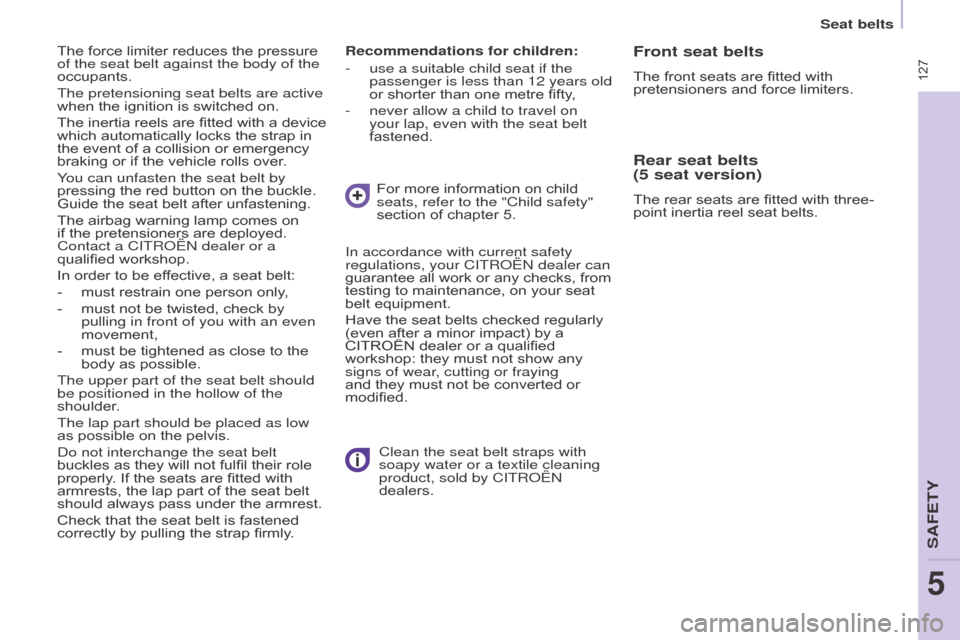
127
Berlingo-2-VP_en_Chap05_Securite_ed02-2015Berlingo-2-VP_en_Chap05_Securite_ed02-2015
Recommendations for children:
-
use a suitable child seat if the
passenger is less than 12 years old
or
shorter than one metre fifty,
-
never allow a child to travel on
your lap, even with the seat belt
fastened. For
more information on child
seats, refer to the "Child safety"
section
of chapter 5.
Clean the seat belt straps with
soapy water or a textile cleaning
product, sold by CITR
o Ë n
dealers.
In accordance with current safety
regulations, your CITR
o Ë n dealer can
guarantee
all work or any checks, from
testing
to maintenance, on your seat
belt
equipment.
Have
the seat belts checked regularly
(even
after a minor impact) by a
CITROËN
dealer or a qualified
workshop:
they must not show any
signs of wear
, cutting or fraying
and
they must not be converted or
modified.
The
force
limiter
reduces
the
pressure
of the seat belt against the body of the
occupants.
The pretensioning seat belts are active
when
the
ignition
is
switched
on.
The
inertia
reels
are
fitted
with
a
device
which
automatically
locks
the
strap
in
the
event
of
a
collision
or
emergency
braking
or
if
the
vehicle
rolls
over.
You can unfasten the seat belt by
pressing
the
red
button
on
the
buckle.
Guide
the
seat
belt
after
unfastening.
The
airbag
warning
lamp
comes
on
if
the
pretensioners
are
deployed.
Contact a CITR
o
Ë
n
dealer or a
qualified
workshop.
In
order
to
be
effective,
a
seat
belt:
-
must
restrain
one
person
only,
-
must
not
be
twisted,
check
by
pullin
g in front of you with an even
movement,
-
must
be
tightened
as
close
to
the
body
as
possible.
The upper part of the seat belt should
be positioned in the hollow of the
shoulder.
The lap part should be placed as low
as
possible
on
the
pelvis.
d
o not interchange the seat belt
buckles
as
they
will
not
fulfil
their
role
properly
.
If
the
seats
are
fitted
with
armrests,
the
lap
part
of
the
seat
belt
should
always
pass
under
the
armrest.
Check
that
the
seat
belt
is
fastened
correctly
by
pulling
the
strap
firmly.Front seat belts
The front seats are fitted with pretensioners and force limiters.
Rear seat belts
(5 seat version)
The rear seats are fitted with three-
point inertia reel seat belts.
SaFETY
5
Seat belts
Page 130 of 292
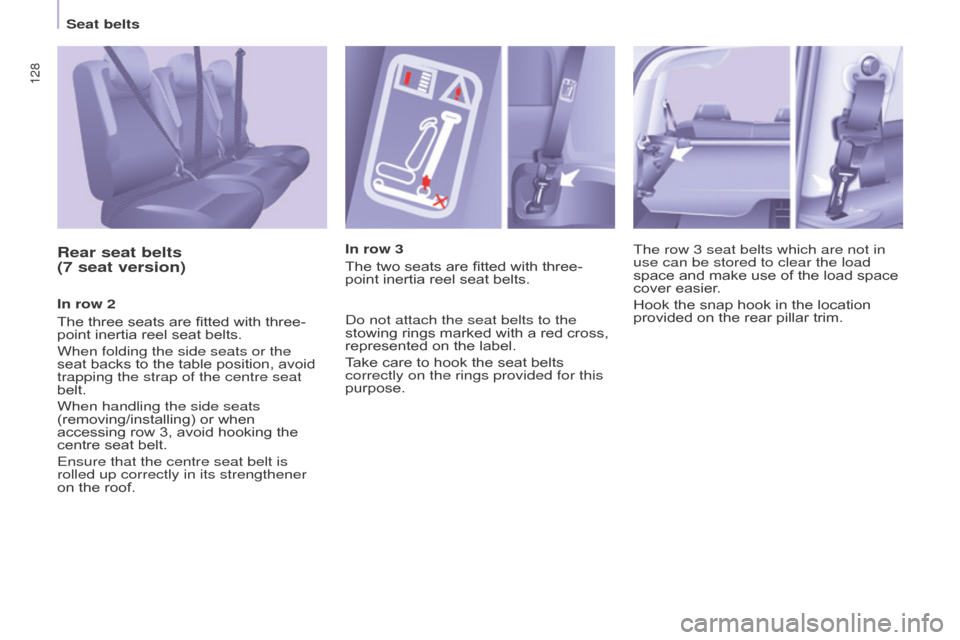
128
Berlingo-2-VP_en_Chap05_Securite_ed02-2015Berlingo-2-VP_en_Chap05_Securite_ed02-2015
Rear seat belts
(7 seat version)
In row 2
The three seats are fitted with three-
point
inertia reel seat belts.
When folding the side seats or the
seat
backs to the table position, avoid
trapping the strap of the centre seat
belt.
When handling the side seats
(removing/installin
g) or when
accessing
row 3, avoid hooking the
centre
seat belt.
Ensure that the centre seat belt is
rolled up correctly in its strengthener
on
the roof. In row 3
The
two seats are fitted with three-
point inertia reel seat belts.d
o not attach the seat belts to the
stowing
rings marked with a red cross,
represented
on the label.
Take
care to hook the seat belts
correctly on the rings provided for this
purpose.The row 3 seat belts which are not in
use can be stored to clear the load
space
and make use of the load space cover
easier.
Hook the snap hook in the location provided
on the rear pillar trim.
Seat belts